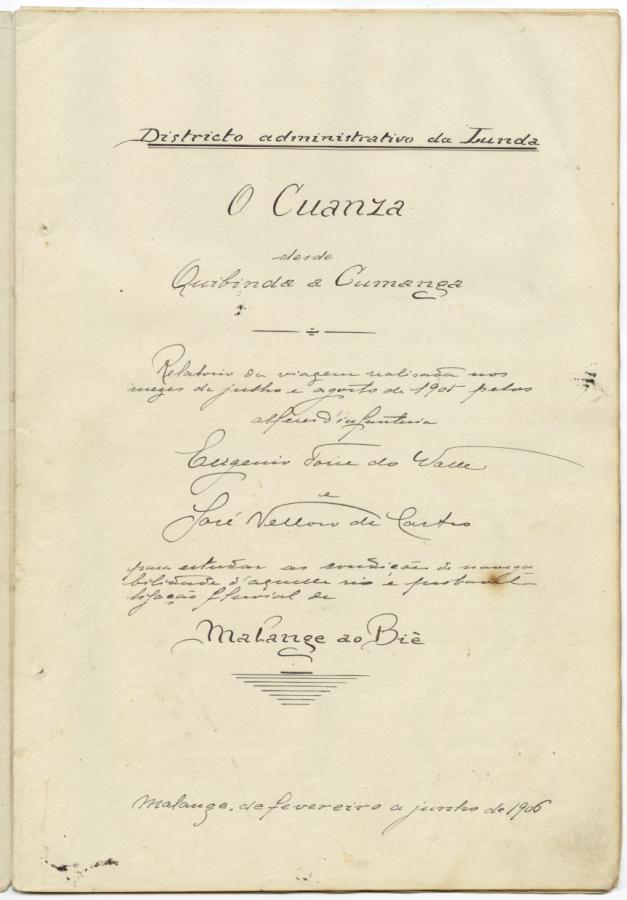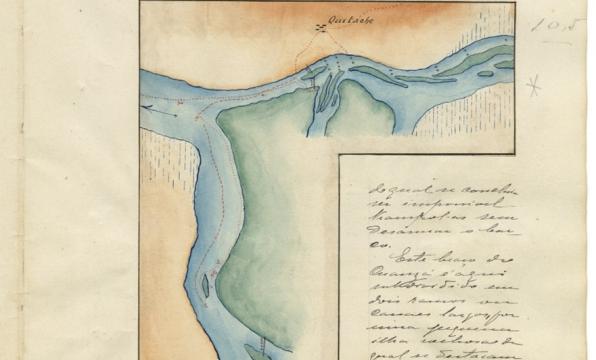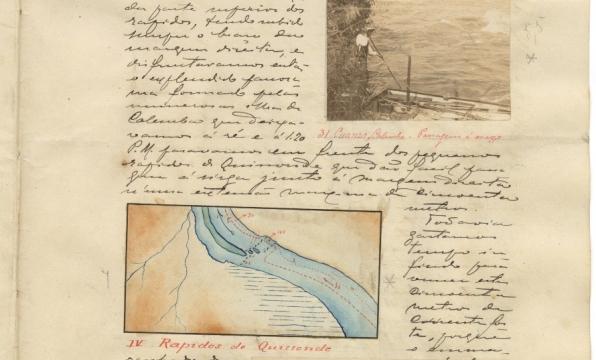
Objeto do mês
Neste mês de setembro, em que se comemora o Dia Mundial dos Rios (29 de setembro), o objeto do mês é um documento intitulado O Cuanza desde Quibinda a Cumanga. Trata-se de um relatório de uma viagem realizada nos meses de julho e agosto de 1905 pelos alferes de infantaria Eugénio Torre do Vale e José Veloso de Castro para estudar as condições de navegabilidade do rio Cuanza e provável ligação fluvial de Malange ao Bié, em Angola. O documento encontra-se disponível para consulta no arquivo do Museu Nacional de História Natural e da Ciência da Universidade de Lisboa. Este relatório integra uma coleção documental chamado “Arquivo de Fronteiras”, que esteve sob a tutela do Centro de Geodesia do antigo Instituto de Investigação Científica Tropical, e que contém processos relacionados com a delimitação das fronteiras das antigas províncias ultramarinas portuguesas, sobretudo em África.
O documento foi elaborado pelos alferes de infantaria Eugénio Torre do Vale e José Veloso de Castro entre fevereiro e junho de 1906. No final do relatório, o documento encontra-se assinado por José Veloso de Castro, no dia 21 de maio de 1906, em Malange, em Angola, então uma província ultramarina portuguesa. Trata-se de um original manuscrito. O relatório terá sido produzido após uma missão no rio Cuanza efetuada pelos dois alferes de infantaria em 1905. A viagem foi incumbida pelo governador do distrito da Lunda para estudar as condições de navegabilidade do rio Cuanza e uma provável ligação fluvial de Malange ao Bié. Esta missão enquadra-se no processo de ocupação efetiva do interior do território de Angola por parte das autoridades portuguesas, no final do século XIX e início do século XX, na sequência do Scramble for Africa efetuada pelas principais potências europeias da época.
O documento foi recebido no Quartel-General da Província de Angola, no dia 16 de janeiro de 1907, como atesta o carimbo do registo de entrada desse organismo presente no relatório. É de presumir que antes tenha sido enviado pelos alferes de infantaria para o governador do distrito da Lunda. Do Quartel-General da Província de Angola terá sido enviado para o Ministério da Marinha e Ultramar, em Lisboa, não antes de 1908, pois data desse ano uma publicação do relatório por esse ministério. O relatório da expedição de Quibinda a Cumanga teria ainda mais duas edições, em 1910 e 1913, este último pela Tipografia da Cooperativa Militar. O documento, além do texto manuscrito, integra também diversas fotografias a preto e branco, bem como, alguns quadros com dados numéricos e inúmeros croquis a cores com a representação cartográfica do território percorrido, num total de 188 páginas.
O relatório divide-se em oito partes referentes aos trechos do percurso que os alferes vão percorrendo ao longo do rio Cuanza: “Instruções”, “Do Condo a Bolla Cassaxi”, “De Bolla Cassaxi á confluência do Luando”, “No Luando”, “Do Luando ao Cunhinga”, “Do Cunhinga ao Cumanga”, “A retirada” e “Conclusões”. Missão incumbida pelo governador do distrito da Lunda, em Angola, ao longo do relatório, os alferes dão informações acerca da navegabilidade do rio Cuanza, determinação do curso do mesmo rio, orografia e hidrografia, flora e fauna, etnografia, informações acerca de comércio e indústria e reconhecimentos militares. Em Cumanga, no final do percurso, chegam à conclusão de que o rio não é mais navegável e que, de Quibinda até ali, o rio só será transitável se forem feitas inúmeras obras de construção, debatendo em seguida sobre a viabilidade das mesmas dada a futura implantação do caminho-de-ferro na região.
Trip report to cuanza
This September, when World Rivers Day (september, 29) is celebrated, the “object of the month” is a document entitled O Cuanza de Quibinda a Cumanga. This is a report of a trip carried out in the months of july and August 1905 by infantry ensigns Eugénio Torre do Vale and José Veloso de Castro to study the navigability conditions of the Cuanza river and the probable river connection from Malange to Bié, in Angola. The document is available for consultation in the archive of the Museum of Natural History and Science of the University of Lisbon. This report is part of a archival collection called “Arquivo de Fronteiras” (trad. “Archive of Frontiers”), which was under the custody of the Centro de Geodesia of the former Instituto de Investigação Científica Tropical (Tropical Scientific Research Institute), and which contains processes related to the delimitation of the borders of the former Portuguese overseas provinces, especially in Africa.
The document was prepared by infantry ensigns Eugénio Torre do Vale and José Veloso de Castro between February and June 1906. At the end of the report, the document is signed by José Veloso de Castro, on May 21, 1906, in Malange, in Angola, then a Portuguese overseas province. It is a handwritten original. The report would have been produced after a mission on the Cuanza River carried out by two infantry ensigns in 1905. The trip was commissioned by the governor of the Lunda district to study the navigability conditions of the Cuanza River and a probable river connection from Malange to Bié. This mission is part of the process of effective occupation of the interior of the territory of Angola by Portuguese authorities, at the end of the 19th century and beginning of the 20th century, following the Scramble for Africa carried out by the main European powers of the time.
The document was received at the Headquarters of the Province of Angola, on January 16, 1907, as evidenced by the entry registration stamp of that organization present in the report. It is to be assumed that it was previously sent by the infantry ensigns to the governor of the Lunda district. From the Headquarters of the Province of Angola it would have been sent to the Ministry and Secretary of State of the Navy and Overseas, in Lisbon, no earlier than 1908, as the report was published by that ministry in that year. The report of Quibinda's expedition to Cumanga would have two more editions, in 1910 and 1913, the latter by Tipografia da Cooperativa Militar. The document, in addition to the handwritten text, also includes several black and white photographs, as well as some tables with numerical data and numerous colored sketches with a cartographic representation of the territory covered, totaling 188 pages.
The report is divided into eight parts referring to the sections of the route that the lieutenants follow along the Cuanza River: “Instructions”, “From Condo to Bolla Cassaxi”, “From Bolla Cassaxi to the confluence of the Luando”, “In Luando” , “From Luando to Cunhinga”, “From Cunhinga to Cumanga”, “The withdrawal” and “Conclusions”. Mission entrusted by the governor of the district of Lunda, in Angola, throughout the report, the ensigns provide information about the navigability of the Cuanza river, determination of the course of the same river, orography and hydrography, flora and fauna, ethnography, information about trade and industry and military recognition. In Cumanga, at the end of the route, they come to the conclusion that the river is no longer navigable and that, from Quibinda to there, the river will only be passable if numerous construction works are carried out, debating then about the viability of these given the future implementation of the railway in the region.
Texto de I Text by: David Gregório, antigo bolseiro de investigação do Museu Nacional de História Natural e da Ciência de Lisboa, nas áreas de Arquivística e História de África| former research fellow at the National Museum of Natural History and Science in Lisbon, in the areas of Archivistics and African History
Digitalização | Scanning by: David Gregório
Valle, Eugénio Torre do e Castro, José Velloso de. O Cuanza desde Quibinda a Cumanga: Relatorio da viagem realizada nos mêses de Julho e Agosto de 1905. Manuscrito. Lisboa: 1906.
Museu Nacional de História Natural e da Ciência da Universidade de Lisboa. Coleção documental “Arquivo de Fronteiras”, Processos de Fronteiras, cx. 3, vol. 10. PT-MUL-IICT-FRO-PF-ANG-03-10-0001.
PROGRAMA ALARGADO
Mais informações brevemente disponíveis.
Preço: bilhete de acesso ao Museu.
Inscrições:
geral@museus.ulisboa.pt | 213 921 808


